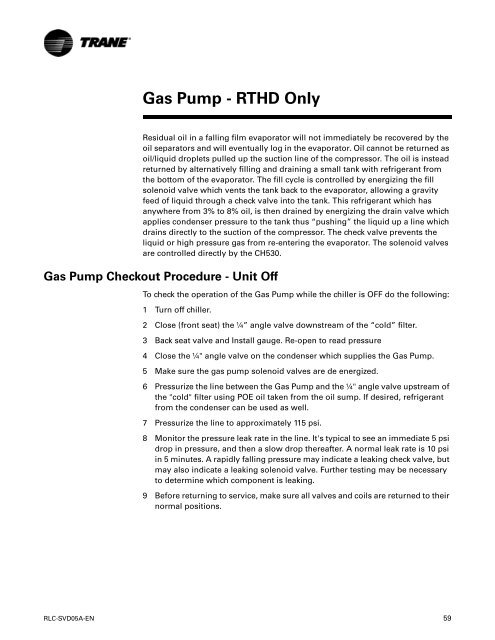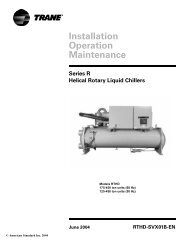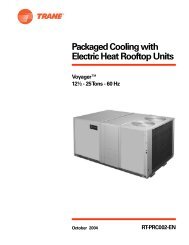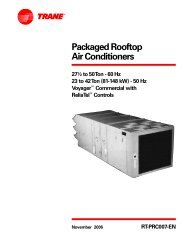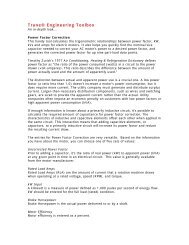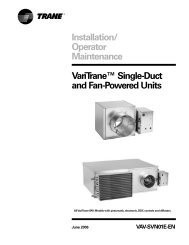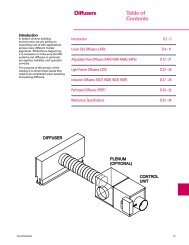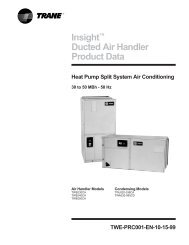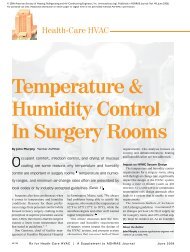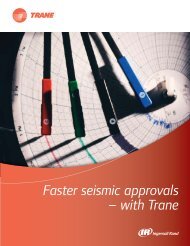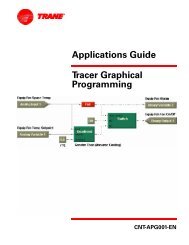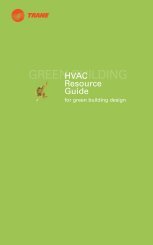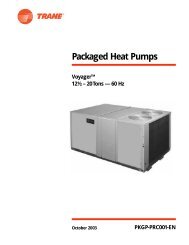RTHD and RTAC - Trane
RTHD and RTAC - Trane
RTHD and RTAC - Trane
You also want an ePaper? Increase the reach of your titles
YUMPU automatically turns print PDFs into web optimized ePapers that Google loves.
Gas Pump - <strong>RTHD</strong> Only<br />
Residual oil in a falling film evaporator will not immediately be recovered by the<br />
oil separators <strong>and</strong> will eventually log in the evaporator. Oil cannot be returned as<br />
oil/liquid droplets pulled up the suction line of the compressor. The oil is instead<br />
returned by alternatively filling <strong>and</strong> draining a small tank with refrigerant from<br />
the bottom of the evaporator. The fill cycle is controlled by energizing the fill<br />
solenoid valve which vents the tank back to the evaporator, allowing a gravity<br />
feed of liquid through a check valve into the tank. This refrigerant which has<br />
anywhere from 3% to 8% oil, is then drained by energizing the drain valve which<br />
applies condenser pressure to the tank thus “pushing” the liquid up a line which<br />
drains directly to the suction of the compressor. The check valve prevents the<br />
liquid or high pressure gas from re-entering the evaporator. The solenoid valves<br />
are controlled directly by the CH530.<br />
Gas Pump Checkout Procedure - Unit Off<br />
To check the operation of the Gas Pump while the chiller is OFF do the following:<br />
1 Turn off chiller.<br />
2 Close (front seat) the ¼” angle valve downstream of the “cold” filter.<br />
3 Back seat valve <strong>and</strong> Install gauge. Re-open to read pressure<br />
4 Close the ¼" angle valve on the condenser which supplies the Gas Pump.<br />
5 Make sure the gas pump solenoid valves are de energized.<br />
6 Pressurize the line between the Gas Pump <strong>and</strong> the ¼" angle valve upstream of<br />
the "cold" filter using POE oil taken from the oil sump. If desired, refrigerant<br />
from the condenser can be used as well.<br />
7 Pressurize the line to approximately 115 psi.<br />
8 Monitor the pressure leak rate in the line. It's typical to see an immediate 5 psi<br />
drop in pressure, <strong>and</strong> then a slow drop thereafter. A normal leak rate is 10 psi<br />
in 5 minutes. A rapidly falling pressure may indicate a leaking check valve, but<br />
may also indicate a leaking solenoid valve. Further testing may be necessary<br />
to determine which component is leaking.<br />
9 Before returning to service, make sure all valves <strong>and</strong> coils are returned to their<br />
normal positions.<br />
RLC-SVD05A-EN 59


